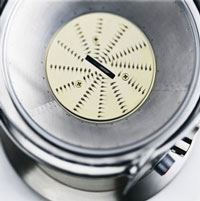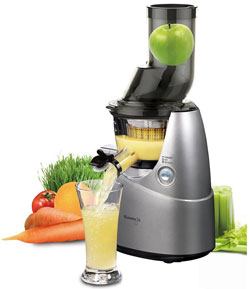Getting started with Juicing
If you’re reading this, you’ve likely heard or read about the phenomenon of “Juicing,” and want to learn more. With countless commercials, infomercials, ads, books, videos – even retail juice “bars” – dedicated to this popular trend, it’s nearly impossible to avoid. But before you jump in and give it a try, you might have some questions.
What exactly is juicing? Why is it so popular? What do you need to get started? What are the important things to consider?
If you’re looking for the answers to these questions, you’ve come to the right place. Let’s take a look.
What is Juicing?
Simply stated, juicing is the process of separating the liquid part of edible produce (namely fruits and vegetables) from its solid parts (the pulp, seeds and skin or rind). It sounds fairly easy, but there are important considerations that complicate the matter a little. Don’t worry. We’ll break it down for you.
Why Juice?
Juicing has exploded in popularity in the past decade or so, mainly because it’s a convenient, fast and easy way to consume fruits and vegetables and all the beneficial vitamins and nutrients they contain. Let’s take a look at these one-by-one.
Convenient
 Eating fruits, and especially vegetables, can require multiple preparation steps that may include cutting, chopping and heating over a range or in an oven or microwave. Then there are the pots and pans, serving plates and dishes, and cooking and eating utensils that are involved. Afterward, you have to clean up the mess you made in the kitchen. With juicing, you simply insert your produce (whole or cut into large chunks) into a juicer appliance and process it. The pulp goes into one container, and the extracted liquid is either dispensed through a spout directly into your glass, or into a built-in beaker. The typical juicer takes up a minimum of counter space, and cleanup is relatively quick and simple. Also, for those who don’t like eating their vegetables, juicing can provide a tasty alternative. By combining green vegetables with fruits and/or sweet root vegetables like carrots, juicing can be a delicious way to overcome your aversion to – and get your minimum daily requirement of – veggies.
Eating fruits, and especially vegetables, can require multiple preparation steps that may include cutting, chopping and heating over a range or in an oven or microwave. Then there are the pots and pans, serving plates and dishes, and cooking and eating utensils that are involved. Afterward, you have to clean up the mess you made in the kitchen. With juicing, you simply insert your produce (whole or cut into large chunks) into a juicer appliance and process it. The pulp goes into one container, and the extracted liquid is either dispensed through a spout directly into your glass, or into a built-in beaker. The typical juicer takes up a minimum of counter space, and cleanup is relatively quick and simple. Also, for those who don’t like eating their vegetables, juicing can provide a tasty alternative. By combining green vegetables with fruits and/or sweet root vegetables like carrots, juicing can be a delicious way to overcome your aversion to – and get your minimum daily requirement of – veggies.
Fast
As opposed to the considerable time it can take to prepare, serve and eat vegetables, it takes just a matter of minutes to prepare and consume most Juice drinks. With most juicers, cleanup consists of disassembling a few parts, rinsing them off, and placing them in your dishwasher or leaving them out to air dry.
Easy
Many juice drinks, using most popular juicer machines, require ten steps or fewer from start to finish, including cleanup. Typically, the only kitchen items required are (possibly) a knife, a juicing machine and a glass. And while juicing recipes vary, many call for only 4-6 simple ingredients.
Great source of essential vitamins, minerals and nutrients
With today’s active lifestyles and abundant fast-food and junk-food options, many of us don’t get enough of the “good stuff” we need in our diets. This can result in low energy, poor sleep, unwanted weight gain, sluggish physical and mental performance, and compromised overall health. You can spend a fortune buying vitamins and supplements, then struggle trying to remember when to take them. And most medical and nutrition experts recommend getting your vitamins and minerals from food sources vs. taking supplements. Juicing (especially Green Juice) is a natural “fast food” option that delivers a concentrated dose of essential vitamins and minerals, as well as beneficial phytochemicals and antioxidants. It’s a great source of the nutrients you need for good health and wellness. It can even help you lose weight, if that’s your goal. And best of all, it tastes good going down!
What kind juicer should you buy?
Unfortunately, and despite some manufacturers’ claims, no single juicer does everything well. And while generally speaking with juicers, you get what you pay for, you don’t necessarily need to break the bank to buy a solid, quality juicer that will meet your juicing needs for years to come. The two most important considerations here are:
- The kind of juice drinks (“wet” vs. “leafy”) you intend to make
- Your juicing budget
There are two basic kinds of juicers: Centrifugal and Masticating. Let’s take a look at each type and its advantages and disadvantages.
Centrifugal Juicers
 These are the most common, and typically the cheapest, type of juicers. They extract juice using a round cutting blade that spins at high speed against a fine stainless steel mesh strainer. The blade pulverizes the fruit and vegetables, and the centrifugal force separates the juice from the pulp and forces it through the strainer.
These are the most common, and typically the cheapest, type of juicers. They extract juice using a round cutting blade that spins at high speed against a fine stainless steel mesh strainer. The blade pulverizes the fruit and vegetables, and the centrifugal force separates the juice from the pulp and forces it through the strainer.
 Pros
Pros
- Less expensive to manufacture and lower retail cost
- Faster juicing time
- Fine mesh screen means practically no pulp left in juice
- Fewer moving parts, and easier to clean
- Smaller countertop footprint
Cons
- Not well-suited for juicing low-moisture leafy greens or grasses
- Good for “wet” produce juicing such as citrus, melons, cucumbers and celery
- Lower net juice yield per produce weight – some liquid remains in pulp
- Fast-spinning blades generate heat that destroys beneficial enzymes and reduces juice quality and shelf life
Recommended Centrifugal Juicers
Masticating Juicer
Much like a meat grinder, these juicers use a slow-turning gear to “chew” fruit and vegetables, gently but tightly compressing them to squeeze out the juice
 Pros
Pros
- Effectively juices all types of fruits and vegetables, including leafy greens
- Higher net juice yield per produce weight – less liquid remains in pulp
- Lower operating speeds mean less heat is generated, preserving more nutrients and enzymes, and extending juice shelf life up to 72 hours
- Some models offer other food processing functions, such as being able to make nut milk, nut butter, sorbet, pasta and ice cream
 Cons
Cons
- Requires more sturdier construction, resulting in higher retail cost
- Allows some pulp to remain in juice
- More difficult to disassemble and clean
Recommended Masticating Juicers
What else should you consider?
Eating vs. Juicing
Some people mistakenly believe that you can forgo eating ANY solid vegetables (and less often fruits) by simply juicing. The fact is, most health experts agree that eating fruits and vegetables – especially in raw form – provides greater health benefits than processing and drinking them through a juicer. And juicing also largely removes any benefits contained in fruit and vegetable fiber (see Juicing vs. Blending below). But consider the time, convenience and practicality of eating raw the following green juice recipe:
- 1 small cucumber
- 1 medium carrot
- 1 green apple
- 1 cup of spinach
- 2 leaves of kale
- ½ lemon
When you weigh the overall benefits and disadvantages of Eating vs. Juicing, Juicing probably comes out on top. The bottom line is: If you have to choose between rarely eating vegetables (or not eating them AT ALL), or consuming them on a regular basis through juicing, then choose juicing. Better yet, try to maintain a healthy balance between solid and juiced fruits and vegetables.
Juicing vs. Blending
On top of your Juicing options, there’s also Blending to consider. While Juicing extracts the liquid from produce, Blending simply liquidizes fruits and vegetables into a thicker “smoothie”-type drink. You’ve probably seen the widely advertised “Bullet” Blending appliances. Blending offers its own advantages and disadvantages.
What produce to Juice
 If you can eat it, you can probably juice it. However, that doesn’t mean you can sample an entire produce department and haphazardly create a juice drink. You might end up with a major case of indigestion, or worse. There are countless recipes available online, as well as in juice “cookbooks.” Click on the following link for some general guidelines and recipes for green Juice drinks. As you’re starting out, stick to 4-5 ingredients per drink. As you get more experience, be creative. Try a mix of fruits, vegetables and greens. It’s OK to have your favorites, but try not to fall into a juicing “rut,” making and drinking the same recipe every day. Variety is key to juicing.
If you can eat it, you can probably juice it. However, that doesn’t mean you can sample an entire produce department and haphazardly create a juice drink. You might end up with a major case of indigestion, or worse. There are countless recipes available online, as well as in juice “cookbooks.” Click on the following link for some general guidelines and recipes for green Juice drinks. As you’re starting out, stick to 4-5 ingredients per drink. As you get more experience, be creative. Try a mix of fruits, vegetables and greens. It’s OK to have your favorites, but try not to fall into a juicing “rut,” making and drinking the same recipe every day. Variety is key to juicing.
When to drink your juice
It’s important to remember that juicing should not be intended as a meal replacement. It’s a supplement. The best time to make and drink your juice is 30 minutes before a meal, on an empty stomach, to maximize nutrient absorption. The ideal time to juice is first thing in the morning, after you’ve fasted all night long, and before your first meal of the day.
How to drink your juice
Don’t gulp or guzzle your juice. Savor it. As funny as it sounds, you should use a chewing motion as you drink your juice. This stimulates saliva production in your mouth, which is the first step in the digestion process.
Fruit juice and blood sugar
For healthy individuals, there are negligible, if any, health risks associated with juicing. However, if you’re diabetic or have been diagnosed pre-diabetic, use care when juicing, especially with fruits. While there are no documented links between fruit juice consumption, even heavy, and the onset of diabetes, juicing can cause an immediate and considerable spike in blood sugar. If you have questions or concerns, consult your doctor.
Storing and transporting juice
 The beneficial nutrients and enzymes released by juicing have a shelf life measured in hours, if not minutes. As soon as it comes out of your juicer, the clock starts ticking. It’s best to drink your juice immediately after you make it. But if you have extra left over or intend to transport some for later (e.g. to work), store it in a tightly sealed container like a glass mason jar with a lid or a thermos. And always refrigerate any leftover juice. As a general rule of thumb, masticated juice can be stored, tightly sealed and refrigerated, up to 72 hours. Centrifuged juice up to 24 hours.
The beneficial nutrients and enzymes released by juicing have a shelf life measured in hours, if not minutes. As soon as it comes out of your juicer, the clock starts ticking. It’s best to drink your juice immediately after you make it. But if you have extra left over or intend to transport some for later (e.g. to work), store it in a tightly sealed container like a glass mason jar with a lid or a thermos. And always refrigerate any leftover juice. As a general rule of thumb, masticated juice can be stored, tightly sealed and refrigerated, up to 72 hours. Centrifuged juice up to 24 hours.
Juicing and sanitation
For somewhat obvious health reasons, it’s important to maintain a clean and sanitary juicer. Never leave a dirty juicer sit after you’ve used it. At the very least, fill a sink with hot, soapy water and place the parts in the sink to soak if you can’t tend to juicer cleanup immediately. The fine food particles created by juicers can clog the screen of centrifugal juicers, and the “worm” screw of masticating juicers. If left to dry, they become rock hard and extremely difficult to remove. Those same particles have a tendency to accumulate in corners and crevices deep inside your juicer, and eventually will set up like glue. If you use your juicer regularly, disassemble and thoroughly scour it at least once a month.





Leave a Comment